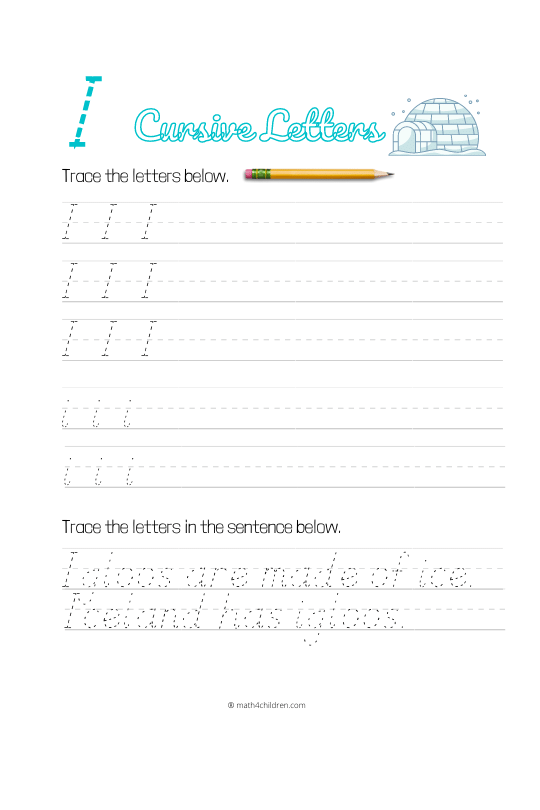![]()
How to do an I in Cursive | How to Do a Cursive i
How to do an I in Cursive - Cursive writing is a style of penmanship where letters are connected in a flowing manner, making it easier to write quickly and smoothly. This writing style has been in use for centuries, and while it may seem outdated to some, it still has a place in today's world. In this article, we will guide you through the process of writing a cursive 'i', both in lowercase and uppercase forms.
Download all A - Z cursive letters here >>
Importance of Cursive Writing
Cursive writing has several benefits that make it a valuable skill to learn and practice, even in our digital age. Some of these benefits include:
Improved Handwriting
Cursive writing generally results in neater and more uniform handwriting. By connecting the letters, cursive forces you to pay closer attention to the formation of each character, thus improving overall legibility.
Increased Writing Speed
As cursive writing connects the letters, it allows for quicker and more efficient writing. This increased speed can be particularly helpful during note-taking or timed exams.
Cognitive Benefits
Cursive writing has been shown to improve brain development, particularly in areas related to fine motor skills, memory, and concentration. These cognitive benefits are especially valuable for children, but adults can benefit as well.
Steps to Write a Cursive 'i'
Now that we understand the importance of cursive writing, let's dive into the process of writing a cursive 'i'.
Step 1: The Lowercase 'i'
- Begin by drawing a slight curve upward from the baseline, moving from left to right.
- As you reach the top, curve back down to the baseline, creating a loop.
- Once you've reached the baseline again, create a small tail that extends to the right. This tail will help connect the 'i' to the next letter in a word.
- Finally, add a dot above the loop to complete the lowercase 'i'.
Step 2: The Uppercase 'I'
- Start by drawing a curved line from the baseline, moving upward and slightly to the right.
- At the top, create a loop by curving the line back down to the left.
- Continue the line downward, passing through the baseline, and create a second loop, similar to the first one.
- Finish the uppercase 'I' by curving the line back up to the baseline, ready to connect to the next letter.
Tips for Writing Cursive 'i
Maintain Consistent Slant
When writing in cursive, it's essential to maintain a consistent slant in your letters. This creates a more uniform appearance and makes your writing easier to read. Practice writing the cursive 'i' with the same slant as your other letters for the best results.
Practice Proper Pencil Grip
A proper pencil grip is crucial for achieving neat, fluid cursive writing. Hold the pencil between your thumb and index finger, resting it against your middle finger. This grip allows for better control and precision while writing.
Use Guideline Sheets
Guideline sheets can be an invaluable tool when learning cursive writing. These sheets provide lines and spaces to help you practice proper letter formation, spacing, and consistency.
Where to Find Guideline Sheets
You can find printable guideline sheets online, or purchase them at your local office supply store. Alternatively, you can create your own by drawing horizontal lines on a blank sheet of paper.
Integrating Cursive 'i' into Words
Once you've mastered writing the cursive 'i', both in lowercase and uppercase forms, it's time to practice integrating the letter into words. Start by writing simple words like "is" and "in" before progressing to more complex words like "imagination" and "intricate." Remember to maintain a consistent slant and practice proper pencil grip as you write.
Conclusion
Cursive writing is a valuable skill with numerous benefits, from improved handwriting to increased writing speed and cognitive development. By following the steps and tips outlined in this article, you'll be well on your way to mastering the cursive 'i'. Keep practicing, and soon you'll be able to write fluid, beautiful cursive with ease.
Frequently Asked Questions
- Is cursive writing still important in the digital age?
Yes, cursive writing still has value in today's world. It improves handwriting, increases writing speed, and provides cognitive benefits that can be beneficial for both children and adults.
- How long does it take to learn cursive writing?
The time it takes to learn cursive writing varies from person to person. With consistent practice, most people can become proficient in a few weeks to a few months.
- What is the best age to teach cursive writing?
Cursive writing is typically taught to children between the ages of 7 and 9, but it can be learned at any age. It's never too late to start learning cursive writing.
- Do I need special tools or materials to learn cursive writing?
No, you don't need any special tools or materials to learn cursive writing. A regular pencil or pen and some paper are all you need. Guideline sheets can be helpful for practicing, but they are not required.
- Can learning cursive writing help improve my print handwriting?
Yes, learning cursive writing can help improve your print handwriting. The attention to detail and fine motor skills developed while practicing cursive can transfer to print writing, resulting in neater and more legible handwriting.

